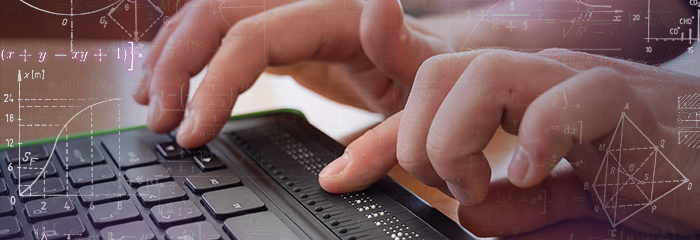- October 17, 2024
- FOXITBLOG
Overcoming Barriers for Individuals with Disabilities – Including Those Who Are Blind, Visually Impaired, or Have Learning Disabilities
As a leading PDF manufacturer, Foxit is actively working on the realization of new PDF 2.0 possibilities. In some cases, multiple stakeholders are needed to make the new functions available to users as a consistent end-to-end solution.
Accessible math is one such example in which Foxit initiated and actively supported a PoC, thus providing the FIRST implementation. (i.e., The practices, resources, and technologies that are designed to make mathematics comprehensible and usable for individuals with disabilities – including those who are blind, visually impaired, or have learning disabilities.)
Accessibility for math was difficult to achieve in PDF 1.7 and PDF/UA-1. As a workaround, an image of the formula with an image description was often used. However, this only works for simple formulas like the Pythagorean theorem or Einstein’s E=mc². However, with complex mathematical formulas, navigation in the formula is particularly necessary.
The introduction of PDF 2.0 and PDF/UA-2 introduced better capabilities for math through MathML. MathML (Mathematical Markup Language) is an XML-based markup language specifically designed for mathematical expressions and formulas. One variant in PDF 2.0 is the so-called “namespace” as a structured object name in a PDF file. There is also the Formula Tag, which points to an embedded file (associated file) that contains the formula. On this basis, math can be made accessible through MathML.
In practice, there was a chicken-and-egg problem because several applications had to work together in order to be able to offer a consistent end-to-end solution. LaTeX is used very often as a word processor for scientific and technical documents containing formulas, such as mathematical or scientific papers at universities and colleges or in scientific publishers or scientific journals.
After creation in LaTeX, finished articles or books are usually converted to PDF. In this way, readers can use a PDF viewer or a PDF editor to view or further edit the texts. To ensure that these scientific publications are also accessible to visually impaired people, the use of a screen reader is necessary. The NVDA and JAWS uses PDF Viewer (in our case, Foxit Reader) to access the PDF. Then, the NVDA can provide read-out-loud or brail access to the content. Currently, only Foxit exposes the math contained in PDFs.
Foxit initiated a proof of concept in the PDF/UA Technical Working Group (TWG) of the PDF Association in order to realize the first implementation in a pilot project. The display and editing of MathML were implemented in the Foxit PDF Editor and PDF Reader. The PDDom interface (API), which has been expanded, is available for communication with a screen reader. For this purpose, we worked intensively with an NVDA expert who implemented the functionality as a plugin for NVDA. Within the PDF Association, there is also the LaTeX Working Group and here Foxit was able to provide support so that formulas in LaTeX can be optimally converted to PDF. The results of this PoC will now gradually be incorporated into the next releases of the applications. This is new work LaTeX is doing, and it will make all PDFs produced from LaTeX ready and PDF/UA-2 compliant.
Foxit is once again a pioneer in making the possibilities of the new PDF standards PDF 2.0 and PDF/UA-2 available to all users.
The community has been working for over 20-years to make math accessible in PDFs – breaking down barriers for those with disabilities. At Foxit, we are proud to be at the forefront of this effort. We hope that our work and progress will inspire other industry leaders – like Apple, Microsoft, and Adobe and the rest of the solutions providers, to take the next steps – from enhancing screen readers like VoiceOver to improving PDF export features and refining PDF viewers. If we all work together, we can create a more inclusive ecosystem – so that everyone can engage with mathematical content seamlessly and meaningfully.
